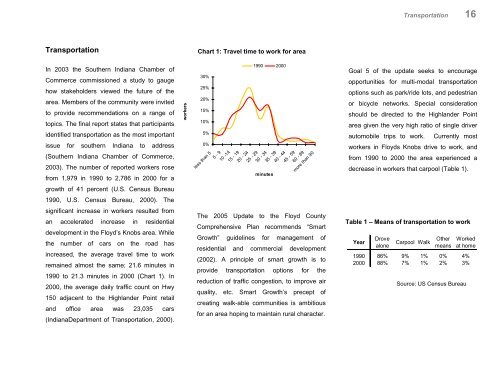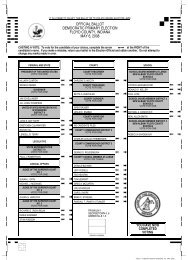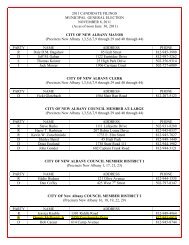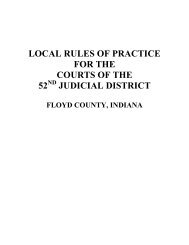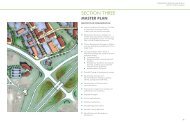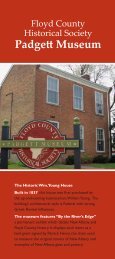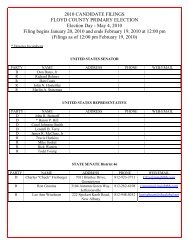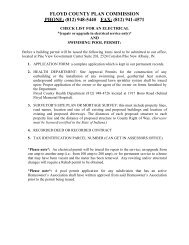HIGHLANDER POINT: A GATEWAY - Floyd County Indiana
HIGHLANDER POINT: A GATEWAY - Floyd County Indiana
HIGHLANDER POINT: A GATEWAY - Floyd County Indiana
Create successful ePaper yourself
Turn your PDF publications into a flip-book with our unique Google optimized e-Paper software.
Transportation 16TransportationChart 1: Travel time to work for areaChart Y - Travel time to workIn 2003 the Southern <strong>Indiana</strong> Chamber ofCommerce commissioned a study to gaugehow stakeholders viewed the future of thearea. Members of the community were invitedto provide recommendations on a range oftopics. The final report states that participantsidentified transportation as the most importantissue for southern <strong>Indiana</strong> to address(Southern <strong>Indiana</strong> Chamber of Commerce,2003). The number of reported workers rosefrom 1,979 in 1990 to 2,786 in 2000 for aworkers30%25%20%15%10%5%0%less than 55 - 910 -1415 - 1920 - 2425 - 2930 - 341990 2000minutes35 - 3940 - 4445 - 5960 - 89more than 90Goal 5 of the update seeks to encourageopportunities for multi-modal transportationoptions such as park/ride lots, and pedestrianor bicycle networks. Special considerationshould be directed to the Highlander Pointarea given the very high ratio of single driverautomobile trips to work. Currently mostworkers in <strong>Floyd</strong>s Knobs drive to work, andfrom 1990 to 2000 the area experienced adecrease in workers that carpool (Table 1).growth of 41 percent (U.S. Census Bureau1990, U.S. Census Bureau, 2000). Thesignificant increase in workers resulted froman accelerated increase in residentialdevelopment in the <strong>Floyd</strong>’s Knobs area. Whilethe number of cars on the road hasincreased, the average travel time to workremained almost the same; 21.6 minutes in1990 to 21.3 minutes in 2000 (Chart 1). In2000, the average daily traffic count on Hwy150 adjacent to the Highlander Point retailand office area was 23,035 cars(<strong>Indiana</strong>Department of Transportation, 2000).The 2005 Update to the <strong>Floyd</strong> <strong>County</strong>Comprehensive Plan recommends “SmartGrowth” guidelines for management ofresidential and commercial development(2002). A principle of smart growth is toprovide transportation options for thereduction of traffic congestion, to improve airquality, etc. Smart Growth’s precept ofcreating walk-able communities is ambitiousfor an area hoping to maintain rural character.Table 1 – Means of transportation to workYearDrovealoneCarpool WalkOthermeansWorkedat home1990 86% 9% 1% 0% 4%2000 88% 7% 1% 2% 3%Source: US Census Bureau


